Welcome to a culinary journey that promises to transform your perception of carrots. These aren’t just any carrots; they are a vibrant, flavorful ode to Moroccan cuisine, perfected for your stovetop. With a delightful balance of aromatic spices and a satisfying hint of crunch, these Moroccan Carrots are more than just a side dish—they’re a celebration of taste. Whether you’re seeking a delicious vegan option, a healthy salad, or a versatile accompaniment for your meals, this recipe delivers on all fronts. They are naturally compliant with Paleo and Whole30 diets, and perfectly suitable for Kosher for Passover menus, making them an incredibly inclusive and delightful addition to any table.

Jump to Recipe
The Culinary Revelation: Why Boiling Carrots Whole is a Game-Changer
Every great recipe has its secrets, and I’m thrilled to share one that will elevate your Moroccan carrots from good to absolutely outstanding: boil them whole. This might seem counter-intuitive to those accustomed to chopping vegetables before cooking, but trust me, it’s a revelation. Not only does this simple technique significantly cut down on prep time, but it also ensures the carrots maintain their structural integrity and vibrant flavor throughout the cooking process. When carrots are boiled whole, they are less prone to becoming waterlogged or mushy, preserving their natural sweetness and firm texture. The outer layer acts as a natural protective barrier, locking in vital nutrients and the distinct earthy flavor of the carrot. This method yields a perfectly al dente carrot that is incredibly easy to slice once cooked, allowing for uniform rounds that absorb the spices beautifully without breaking apart. This secret is key to achieving that signature delightful crunch that makes these Moroccan Carrots so irresistible.
Exploring further, if you’re seeking more Healthy Passover Recipes, you’re in for a treat. Discover new and exciting ways to enjoy Kosher for Passover dishes while maintaining a balanced diet. Dive into a collection of Vegetarian and Vegan Recipes for Passover that promise flavor and tradition.
A Taste of Tradition: The Zafrani Family Legacy in Every Bite
This cherished recipe for Moroccan Carrots holds a special place in my heart, passed down through generations. My dear friend Janice, whose culinary skills were honed by her Moroccan mother-in-law, introduced me to the Zafrani family’s exquisite cuisine. Their food is legendary, bursting with layers of flavor derived from the fragrant spices that are the hallmark of Moroccan cooking. Over the years, our families have shared countless holidays and meals, and without fail, “the carrots” always earn a prime spot on the menu. From the moment you taste them, you’ll understand why. I’ve been making this particular Moroccan carrot salad for over fifteen years, and its consistent perfection never ceases to impress. The carrots are impeccably spiced, offering a tangy kick alongside a slightly firm texture that is wonderfully satisfying. My family never tires of this easy side dish, and I’m always happy to prepare it, knowing how simple yet impactful the recipe is. It’s more than just food; it’s a connection to a rich culinary heritage and a testament to the power of shared meals.
Mastering the Flavor Profile: Essential Ingredients and Smart Substitutions
The magic of these Moroccan Carrots lies in the careful selection and combination of a few key ingredients, each playing a vital role in crafting their distinctive taste. Let’s delve into what makes these components indispensable and how you can adapt them if needed:
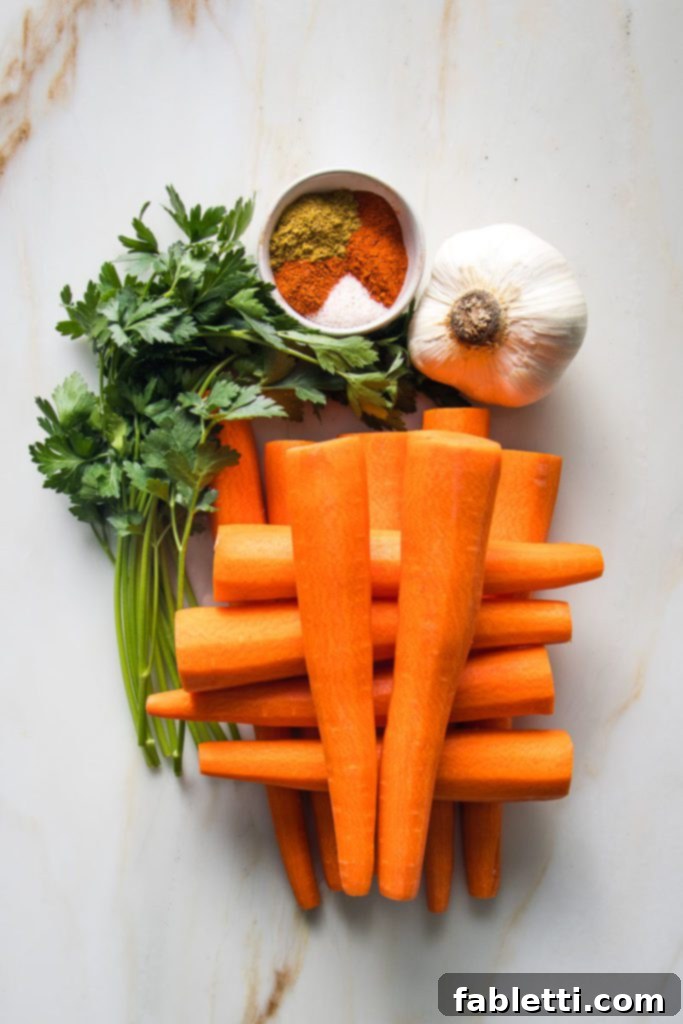
- Carrots: The star of the show! For this recipe, I highly recommend seeking out the largest carrots you can find. Larger carrots tend to hold up better during the whole-boiling process, resulting in a more satisfying texture and richer flavor. However, any size of mature carrot will work wonderfully, just avoid those tiny baby carrots that are often pre-peeled and lack the same depth of flavor. Feel free to experiment with different varieties like purple, yellow, or white carrots for a visually stunning salad. Parsnips also make an excellent substitute, offering a slightly different, yet equally delicious, earthy sweetness. Carrots are packed with beta-carotene, an antioxidant that converts to Vitamin A, crucial for vision and immune function, making this dish not just tasty, but incredibly nutritious.
- Olive Oil: A generous drizzle of extra virgin olive oil at the end adds a silky richness and helps to meld the flavors together. Its fruity notes complement the spices beautifully. If you prefer a no-oil approach, you can certainly skip it without needing a substitution, as the vibrant flavors from the spices and vinegar will still shine through. However, for those who appreciate it, a good quality olive oil enhances the overall mouthfeel and absorption of fat-soluble vitamins in the carrots.
- White Vinegar: Just a splash of white vinegar provides the essential tangy counterpoint that brightens the entire dish and balances the richness of the spices. While white vinegar is preferred for its clean, sharp acidity, you can successfully substitute it with white wine vinegar or even rice vinegar if those are what you have on hand. It’s important to avoid balsamic vinegar in this recipe, as its distinct sweetness and dark color would significantly alter the desired flavor profile and appearance. The vinegar is crucial for awakening the flavors and giving the salad its characteristic zing.
- Garlic: Fresh garlic is paramount here. Its pungent, aromatic notes are foundational to Moroccan cuisine, infusing the carrots with a robust warmth. While garlic powder can offer a hint of flavor in a pinch, it simply doesn’t compare to the depth and vibrancy that freshly pressed garlic provides. Opt for fresh cloves whenever possible for the most authentic and impactful taste.
- Spices: This is where the true “magic” happens, distinguishing Moroccan Carrots from any other. We utilize a blend of two types of paprika and cumin, creating a complex and deeply aromatic profile. Sweet paprika offers a mild, earthy, slightly sweet flavor and a beautiful red hue, while hot paprika introduces a subtle warmth and gentle heat without overpowering the dish. Cumin, with its earthy, nutty, and slightly bitter notes, ties all the flavors together, lending an authentic Moroccan touch. Together, these spices create a rich, savory, and subtly spicy experience that is truly unforgettable. Don’t be shy with them; these carrots are meant to be loaded with flavor!
- Parsley: A sprinkle of fresh parsley is more than just a garnish; it adds a burst of vibrant green color and a refreshing, herbaceous note that brightens the entire salad. Its fresh, slightly peppery flavor provides a lovely contrast to the warm spices. If fresh parsley isn’t available, fresh cilantro can be used as an equally delicious and aromatic alternative, offering a slightly different but complementary flavor profile that is also common in Moroccan cooking.
Step-by-Step Guide: Crafting Your Perfect Moroccan Carrot Salad
Making these Moroccan Carrots is surprisingly simple, especially once you’ve mastered the ‘boil them whole’ technique. Follow these detailed steps to achieve a perfectly seasoned and textured carrot salad every time:
Step One: Prepare the Carrots for Cooking. Begin by thoroughly preparing your carrots. This involves trimming both ends, then either scrubbing them meticulously clean under running water to remove any dirt or gently peeling them if you prefer. While peeling is optional, scrubbing helps retain more nutrients and fiber. Once cleaned, place the whole carrots into a large saucepan. Ensure the pan is large enough to comfortably hold all the carrots in a single layer or stacked minimally. Cover the carrots generously with cold water, extending about 2 inches above the carrots themselves. This ensures even cooking.
Step Two: Perfectly Cook the Carrots. Bring the water in the saucepan to a rolling boil over high heat. Once boiling vigorously, reduce the heat to a gentle simmer and let the carrots cook, uncovered. The crucial goal here is to cook them until they are tender yet still firm, offering a satisfying resistance when bitten—what chefs call “al dente.” The cooking time will vary depending on the size of your carrots, typically ranging from 12 to 20 minutes. It’s imperative to start checking them early, around the 10-minute mark, to prevent them from becoming mushy, which would compromise the desired texture of your salad. A fork should easily pierce the carrot, but it shouldn’t feel completely soft or break apart.
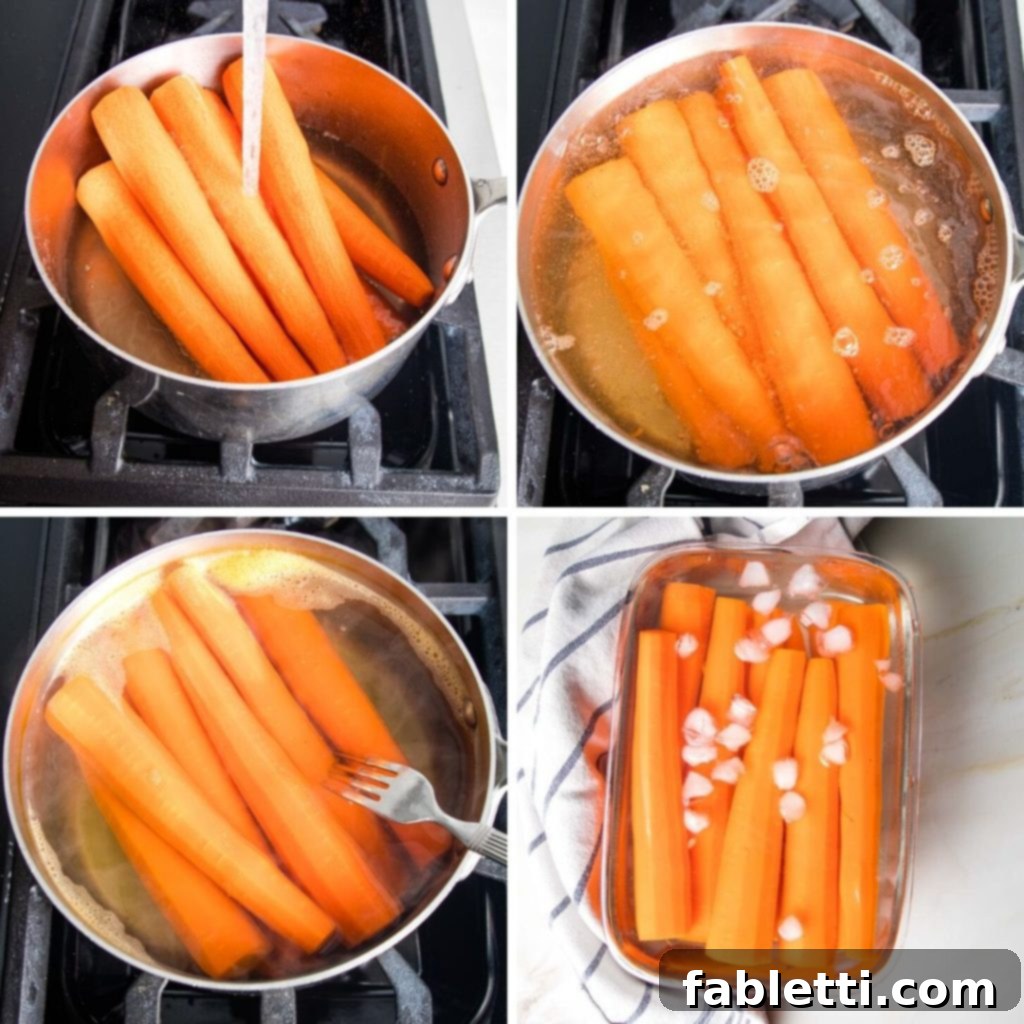
Step Three: Rapid Cooling for Optimal Texture. To halt the cooking process immediately and preserve that perfect al dente bite, you need to rapidly cool the carrots. The easiest and most effective way to do this is by preparing an ice bath beforehand. Fill a large bowl with ice and cold water. As soon as the carrots reach their desired tenderness, use tongs to swiftly transfer them from the hot cooking water directly into the waiting ice bath. Let them sit in the ice water for a few minutes until they are completely cooled through. This shock treatment prevents further cooking and ensures they retain their crisp texture.
Step Four: Drain, Dry, and Slice with Ease. Once the carrots are thoroughly chilled, drain them completely from the ice bath. It’s important to pat them dry with a clean kitchen towel to remove excess moisture, which helps the spices adhere better. This is where the magic of boiling them whole truly shines: the cooked carrots will now be incredibly easy to slice. You can comfortably hold each carrot with a fork in one hand and use any sharp knife to effortlessly slice them into uniform ¼-inch rounds. The evenness of the slices contributes to a consistent texture and allows each piece to be perfectly coated in the dressing. Once all the carrots are sliced, transfer them into a large mixing bowl, ready for seasoning.
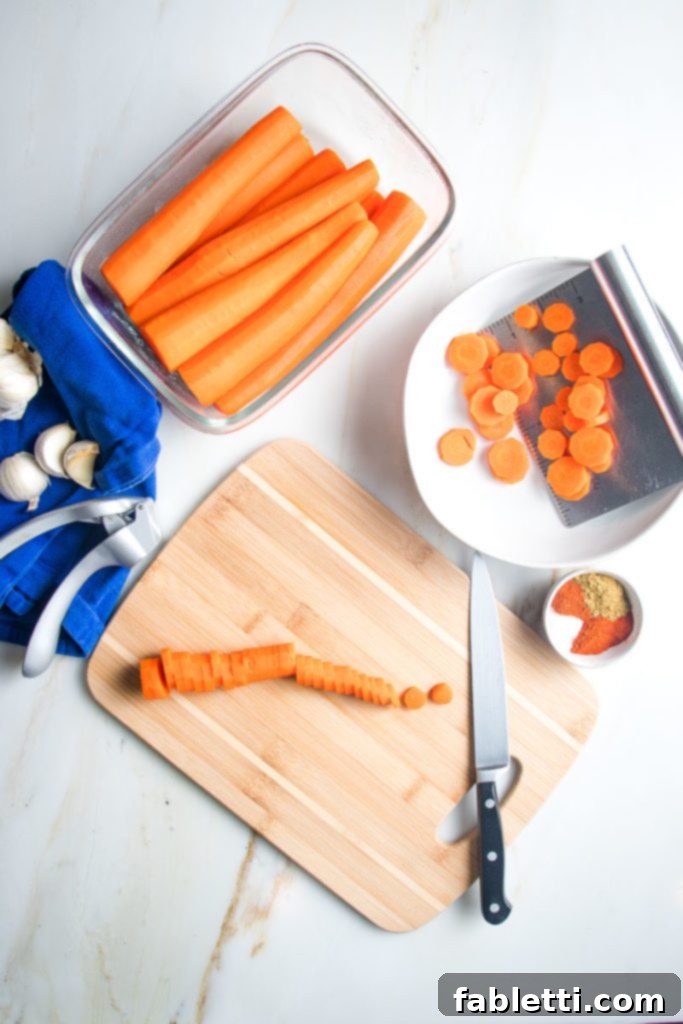
Step Five: Season and Mix to Perfection. Now it’s time to bring all the flavors together. Using a garlic press, squeeze the fresh garlic directly over the sliced carrots in the bowl. Drizzle in the olive oil and white vinegar. Then, generously sprinkle on the sweet paprika, hot paprika, cumin, and salt. With a spoon or your hands, mix everything thoroughly, ensuring that every single carrot round is evenly coated with the fragrant spices and tangy dressing. Taste a piece to check the seasoning; you might want to add a touch more salt to enhance the flavors. Finally, sprinkle in the freshly chopped parsley and mix one last time. This fresh herb adds a vibrant splash of color and a refreshing lift to the warm, earthy spices.

Why This Moroccan Carrot Recipe Truly Shines Above the Rest
Before discovering this particular recipe from Janice and Max, I explored countless Moroccan carrot variations. While many shared common ingredients like carrots, garlic, vinegar, and spices, none achieved the exquisite balance of flavor and texture found in this specific preparation. There are several reasons why this recipe has become a staple and is, without a doubt, the best:
- Unmatched Texture and Taste: What set this recipe apart immediately was the superior texture. Other recipes often resulted in carrots that were either too soft or unevenly cooked, leading to a less satisfying experience. This recipe consistently delivers carrots that are perfectly al dente—tender enough to yield easily but firm enough to retain a pleasant, subtle crunch. This texture, combined with the harmonious blend of spices, creates a taste that is both robust and refreshing, far surpassing the often-milder or less balanced flavors of other versions.
- The “Boiling Whole” Advantage: A Culinary Revelation: Remember the secret I shared earlier? Cooking the carrots whole is an absolute game-changer. Beyond the convenience of easier slicing once cooked, this method offers a critical advantage in terms of even cooking. When carrots are boiled whole, they cook uniformly from the outside in, eliminating the problem of smaller pieces becoming overcooked and mushy while larger chunks remain too firm. This ensures every single slice of carrot in your salad has that ideal texture, enhancing the overall enjoyment of the dish. Furthermore, boiling whole helps to preserve more of the carrots’ natural sugars and nutrients, preventing them from leaching into the cooking water as readily as they would from cut pieces.
- The Perfect Spice-to-Vinegar Ratio: A Symphony of Flavors: The specific ratio of spices and vinegar in this recipe is, to me, nothing short of perfect. It strikes a magnificent balance, offering a delightful tanginess from the vinegar that beautifully cuts through the warmth and depth of the paprika and cumin. The flavors are vibrant, bold, and incredibly well-rounded, avoiding the common pitfalls of being either too sour or too bland. While I might have introduced the fresh parsley over the years as my own subtle touch to the original Zafrani family recipe, the foundational spice and vinegar balance remains true to its origins. And in our home, these remain affectionately known as “Janice’s carrots,” a testament to their enduring appeal and the wonderful friendship that brought them into our lives.
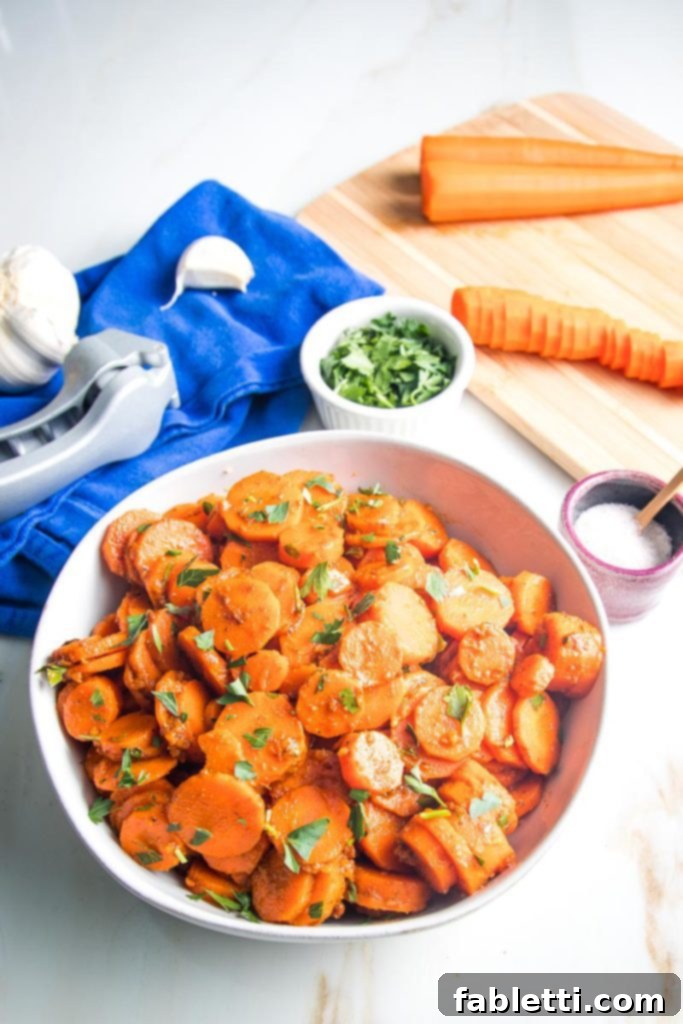
Serving Suggestions & Perfect Pairings for Moroccan Carrots
These Moroccan Carrots are incredibly versatile, making them a fantastic addition to almost any meal, from weeknight dinners to festive holiday gatherings. Their bright, tangy, and spiced profile allows them to complement a wide range of main courses. Serve them chilled as a refreshing side salad alongside grilled chicken, roasted lamb, or pan-seared fish. They are also an excellent accompaniment to heartier stews and tagines, providing a much-needed burst of freshness and acidity to balance rich flavors. For a vegan or vegetarian meal, pair them with quinoa, couscous, or a lentil dish. They shine particularly bright during holiday meals, especially for Passover, where they offer a vibrant, healthy, and flavorful option that everyone can enjoy. Don’t limit them to just dinner; they make a fantastic addition to a mezze platter or as part of a vibrant lunch spread.
Storage and Make-Ahead Tips
One of the many advantages of this Moroccan Carrot recipe is how wonderfully it lends itself to meal prep. The flavors actually deepen and meld even further after a day or two in the refrigerator, making it an ideal make-ahead dish for busy weeks or upcoming events. Once prepared, transfer the spiced carrots to an airtight glass food storage container. They will keep beautifully in the refrigerator for up to a week, maintaining their excellent texture and vibrant flavor. This makes them perfect for grab-and-go lunches, quick side dishes, or for having a healthy, flavorful component ready for any meal. Simply take them out of the fridge and serve cold or at room temperature – both ways are delicious!
Frequently Asked Questions (FAQ) About Moroccan Carrots
- Can I use baby carrots for this recipe?
- While you technically *can* use baby carrots, I highly recommend against it. The core secret to this recipe’s success is boiling whole, larger carrots which retain their shape, flavor, and crucial al dente texture better. Baby carrots tend to become mushy and lack the robust flavor of their mature counterparts.
- How can I adjust the spice level?
- The beauty of this recipe is its adaptability. If you prefer a milder flavor, you can reduce or omit the hot paprika. For those who love more heat, feel free to add an extra pinch of hot paprika or a tiny dash of cayenne pepper. Always taste and adjust to your preference!
- Is this recipe exclusively for Passover or holidays?
- Absolutely not! While these Moroccan Carrots are a beloved fixture at Zafrani family holiday meals, they are so delicious and easy to make that they deserve a spot on your table year-round. They make a fantastic, healthy side dish for any weeknight dinner, potluck, or casual gathering.
- Can I make this recipe oil-free?
- Yes, you can! The olive oil adds richness and helps meld the flavors, but if you’re strictly avoiding oil, you can omit it entirely. The vibrant spices and vinegar will still provide plenty of flavor.
- What other fresh herbs can I use if I don’t have parsley or cilantro?
- While parsley and cilantro are traditional and recommended for their flavor profiles, if you’re in a pinch, you could try a very small amount of finely chopped fresh mint for a different, refreshing twist. However, for the authentic Moroccan flavor, parsley or cilantro are your best bet.
And speaking of essential elements, beyond these incredible carrots, what do you think is indispensable to meals (holiday or not) in our home? If you guessed guacamole, you’re absolutely right! Once a Cali Girl, always a Cali Girl!
Did you know commenting and rating recipes is one of the best ways to support your favorite food bloggers? If you made this recipe, please consider leaving a five-star rating below and a comment sharing your experience. Also, we’d love to see your creations! Please share your photos on Instagram by tagging me @dkhealthcoach and using the hashtag #debraklein.
Moroccan Carrots: The Full Recipe
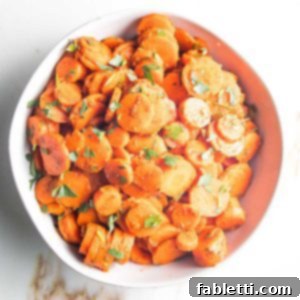
Moroccan Carrots
Author: Debra Klein
The easiest way to make Moroccan Carrot Salad. Super tasty, never soggy, time efficient and compliant for Paleo and Whole30. The perfect side dish or salad during Passover and year round.
Print Recipe | Pin Recipe
Prep Time: 3 mins
Cook Time: 15 mins
Additional Time: 5 mins (for cooling)
Total Time: 23 mins
Course: Salad
Cuisine: Moroccan
Servings: 6 cups
Calories: 97 kcal
Equipment
- Measuring Cups and Spoons
- Glass Food Storage Containers
- OXO Good Grips Swivel Peeler
- Garlic press
Ingredients
- 3 lbs. carrots*
- 2 Tablespoons olive oil
- 2 teaspoons white vinegar
- 3 cloves garlic, pressed
- 1 Tablespoon sweet paprika*
- 2 teaspoons cumin*
- 1 teaspoon hot paprika
- 1 teaspoon salt
- ¼ cup fresh parsley*, chopped
Instructions
- Prepare Carrots: Trim and then either scrub well or peel. Place whole carrots in a sauce pan, cover with cold water by 2 inches. Bring to a boil and then reduce heat to a simmer, cooking uncovered.
- Prepare Ice Bath: Meanwhile, prepare an ice water bath in a large bowl. This will be used to promptly stop the cooking process when carrots are done.
- Cook Carrots to Perfection: Carrots will take 12-20 minutes, depending on size. Large carrots typically take about 15 minutes. It is best not to overcook; the carrots taste best when al dente (tender but still firm). Carrots are done when you can easily prick them with a fork.
- Rapidly Cool: Transfer carrots immediately, using tongs, to the waiting ice bath. Let them cool completely.
- Drain and Dry: Once cooled, drain the carrots thoroughly from the ice bath and pat them dry with a clean kitchen towel.
- Slice and Season: Slice the cooled carrots into ¼-inch rounds. Place them in a bowl. Press garlic onto carrots, drizzle with olive oil and vinegar, then sprinkle on the sweet paprika, cumin, hot paprika, and salt. Mix well to fully distribute all the spices and liquids. Taste for seasoning, adding more salt as needed. Finally, sprinkle with chopped fresh parsley and mix again.
- Serve or Store: These spiced carrots will stay fresh and delicious in the fridge for up to a week. Serve them cold or at room temperature as a side dish or salad.
Video
Notes
- *Approximately 3 pounds of carrots equates to 10-12 extra-large carrots. Adjust quantities based on carrot size.
- *For paprika, if you don’t have both sweet and hot varieties, use a total of 1 Tablespoon + 1 teaspoon of your preferred paprika (e.g., Turkish, smoked). To introduce some heat, add 1 teaspoon of white pepper or ¼ teaspoon of cayenne pepper.
- *If preparing for Passover, omit the cumin.
- *If fresh parsley is unavailable, fresh cilantro makes an excellent alternative for garnish and flavor.
Nutrition
Serving: 1g | Calories: 97kcal | Carbohydrates: 15g | Protein: 2g | Fat: 4g | Saturated Fat: 1g | Polyunsaturated Fat: 3g | Sodium: 366mg | Fiber: 6g | Sugar: 6g
The nutrition calculations provided here are estimates generated using online tools. For the most accurate representation of nutritional information in any given recipe, it is recommended to calculate with the actual ingredients you use. You are ultimately responsible for ensuring that any nutritional information you rely upon is accurate, complete, and useful for your specific dietary needs.
Did you make this recipe?
Please leave a review below, then snap a picture and tag me @dkhealthcoach or use hashtag #dkhealtcoach on Instagram so I can see it!!
